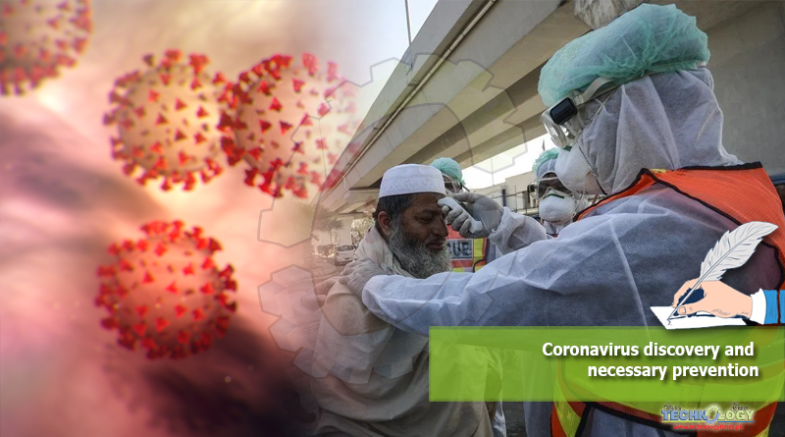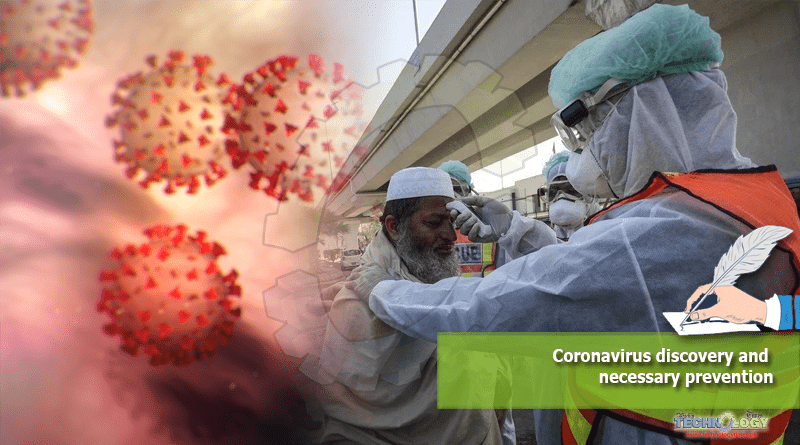Coronavirus discovery is one of the major challenges of recent times for the whole World. All developed or developing countries are being affected by this deadly virus. To tackle this global problem, we must know what coronavirus actually is and which prevention should be adopted against the coronavirus.

Coronavirus discovery have been made in mice, turkeys, cats, horse and humans, and cause various diseases including respiratory tract and gastroenteritis. Two human viruses (HCoV-229E and HCoV-OC43) were identified in the mid-1960s and are known to cause the common cold. The most vulnerable coronaviruses in recent past are SARS-CoV and MERS-CoV and the most recent 2019 novel coronavirus (COVID-19).
Coronaviruses, a genus of the corona-viridae family, are enveloped viruses having large plus strand RNA genome. The size of genomic RNA is 27-32 kb and poly adenylated. There are three groups of coronaviruses that is serologically distinct. Viruses are characterized within each group by their genomic sequence and host range.
COVID-19 are enveloped positive strand RNA viruses which have club-like spikes at the surface having a unique replication process and a large RNA genome (~25kb). Coronaviruses are known as one of major pathogenic viruses causing a variety of diseases in birds and mammals including humans (lethal respiratory dysfunctions).
The recent outbreak of new strain of coronavirus is identified with different names i.e. SARS-CoV-2 or 2109 Novel Coronavirus, but World Health Organization (WHO) announced it as COVID-19. Multiple cases of COVID-19 attacks are being diagnosed all over the World. COVID-19 showed high death rate exponentially, however, not even a single effective cure is being introduced yet against this deadly virus.
The recently identified SARS-CoV cause a life-threatening pneumonia and is the most pathogenic human coronaviruses identified thus far. SARS-CoV is probable to occupy in animal source, and recently initiated the epidemic in humans through zoonotic transmission. SARS-CoV is the first membrane of a fourth group of coronaviruses.
Coronavirus discovery
The origin of COVID-19 is yet not identified but the source of coronavirus spread is believed to be a “sea food market” in Wuhan, Hubei province, China. In Wuhan, a cluster of patients linked with its seafood market have the third zoonotic human coronavirus (COVID-19) of the century emerged on 31st of December 2019.
COVID-19 is similar to Sever Acute Respiratory Syndrome coronavirus (SARS-CoV) and Middle East Respiratory Syndrome coronavirus (MERS-CoV) infections including fever, lung infiltration and difficulty breathing.
After an extensive speculation about the causative agent of CoV, the identification of COVID-19 announced by the Chinese Center for Disease Control (CDS) on 19th of January 2020. The 2019 novel CoV (COVID-19) was isolated from a single patient and later corroborated from 16 more patients. The viral pneumonia of COVID-19 was quickly predicted as likely causative agent, while not yet confirmed.
This virus is spreading like a jungle fire. By the time these lines are written, all over the world: 203,617 people are known to be infected; 8,227 deaths have been recorded; and 82,866 patients have been cured from this virus. But these figures are increasing almost on hourly basis.
Cure and medications
Till now, there is not even a single perfect medication is devised except using traditional medications. Some classic Chinese drugs are being trialed against coronavirus, which are most considered as most effective as China has cured it’s all patients and controlled new infections. Drugs previously used against Ebola virus and HIV are also being used. Scientists are striving to solve this puzzle.
Preventive measures
This novel coronavirus appears to be spreading among people. It is thought that may coronavirus is being spread through respiratory droplets when someone infected with the virus coughs or sneezes. It’s unclear exactly how contagious the virus is?
COVID-19 symptoms can be mild to severe fever, cough and shortness of breath. Symptoms may appear two to 14 days after exposure. COVID-19 vaccine is not currently available. WHO and several centers for disease control and prevention recommended to take the usual precautions for avoiding COVID-19, as following:
- Wash hands with soap and water or use an alcohol-based hand sanitizer.
- Cover mouth and nose with tissue when sneeze or cough.
- Avoid to touching eyes, nose and mouth if hands are not clean.
- Avoid close contact with coronavirus patients.
- Stay at home, avoid unnecessary outings.
- Avoid eating raw or undercooked meat or animal organs, especially outside food.
- If visiting live markets in areas that recently have new coronavirus cases, avoid contact with live animals and surfaces they may have touched.
- Avoid international or regional traveling.
Be safe and inform everyone about the danger of coronavirus, but don’t be panic. Follow the time tested old saying “Care is better than cure”. Everyone should have to strictly follow the precautionary measures.
This article is jointly written by Dr. Sheikh Arslan Ashraf Sehgal and Muhammad Waqas Javid, from Department of Bioinformatics and Biotechnology, Government College University Faisalabad, Pakistan.
